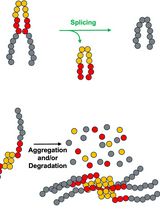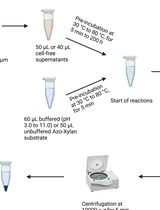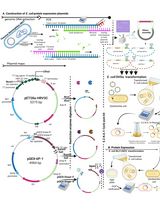- EN - English
- CN - 中文
Immunoprecipitation of Cell Surface Proteins from Gram-negative Bacteria
革兰氏阴性菌细胞表面蛋白的免疫沉淀
(*contributed equally to this work) 发布: 2017年05月05日第7卷第9期 DOI: 10.21769/BioProtoc.2250 浏览次数: 9432
评审: Valentine V TrotterChristian RothAnonymous reviewer(s)
Abstract
The meningococcus (Neisseria meningitidis) remains an important threat to human healthworldwide. This Gram-negative bacterium causes elevated disabilities and mortality in infectedindividuals. Despite several available vaccines, currently there is no universal vaccine against allcirculating meningococcal strains (Vogel et al., 2013). Herein, we describe a new protocol that iscapable of identifying only cell surface exposed proteins that play a role in immunity, providing thisresearch field with a more straightforward approach to identify novel vaccine targets. Even though N. meningitidis is used as a model in the protocol herein described, this protocol can be used for anyGram-negative bacteria provided modifications and optimizations are carried out to adapt it to differentbacterial and disease characteristics (e.g., membrane fragility, growth methods, serum antibody levels,etc.).
Keywords: Gram-negative (革兰氏阴性)Background
Attempts to develop novel vaccines against N. meningitidis often rely on 2D SDS-PAGE (two-dimensional sodium dodecyl sulfate-polyacrylamide gel electrophoresis) and Western blotfollowed by MS (mass spectrometry) (Wheeler et al., 2007). However, such approach employs wholecell lysate, identifying a plethora of proteins that do not have vaccine potential (Mendum et al., 2009).We therefore aimed at developing a method capable of identifying only cell surface exposed proteinsthat might play important role in immunity. Briefly, our protocol consists in growing the pathogen ofinterest, immunoprecipitating surface antigens with sera of immune individuals, and identifyingimmunoprecipitated proteins by liquid chromatography-tandem mass spectrometry. We were able toidentify 23 meningococcal surface antigens using this new protocol, some of which are components ofcommercially available vaccines (Newcombe et al., 2014). We also have adapted this protocol to otherGram-negative bacteria and have obtained promising results: we identified previously describedsurface-exposed proteins, many of which have already been tested as vaccine or diagnostic testcandidates. These results show this is a robust technique that can be applied to a diverse range ofGram-negative bacteria and capable of yielding high-quality results that can be further exploited by amyriad of applications (e.g., vaccines, diagnosis, etc.).
Materials and Reagents
- Disposable Petri dishes (Cromwell Group, catalog number: STS3855002B )
- L-shaped cell spreaders (Fisher Scientific, catalog number: 14-665-231 )
- Disposable inoculating loop (Sigma-Aldrich, catalog number: I8388 )
- 1.5 ml microcentrifuge tubes (Corning, Axygen®, catalog number: MCT-150-C )
- Protein LoBind tube (Eppendorf, catalog number: 022431102 )
- 20 ml plastic universals (Thermo Fisher Scientific, Thermo ScientificTM, catalog number: 128BFS )
- Plastic sealable bags (Fisher Scientific, catalog number: 10366984)
Manufacturer: MINIGRIP, catalog number: BAJ-340-091N . - PierceTM spin columns (Thermo Fisher Scientific, Thermo ScientificTM, catalog number: 69725 )
- Disposable sterile scalpel No. 10 (WMS, catalog number: W259 )
- 10 µl Filter tips (STARLAB INTERNATIONAL, TipOne®, catalog number: S1121-3810 )
- 20 µl Filter tips (STARLAB INTERNATIONAL, TipOne®, catalog number: S1120-1810 )
- 200 µl Filter tips (STARLAB INTERNATIONAL, TipOne®, catalog number: S1120-8810 )
- 1,000 µl Filter tips (STARLAB INTERNATIONAL, TipOne®, catalog number: S1122-1830 )
- Neisseria meningitidis (strains L9153 and MC58, Public Health England)
- Phosphate-buffered saline (PBS) (Thermo Fisher Scientific, GibcoTM, catalog number: 10010001 )
- Bovine serum albumin (BSA) (Sigma-Aldrich, catalog number: A9418 )
- Human serum (Sigma-Aldrich, catalog number: H6914 )
- Disease state serum (acquisition of this varies and depends on the pathogen being investigated)
- PierceTM Protein A/G UltraLinkTM Resin (Thermo Fisher Scientific, Thermo ScientificTM, catalog number: 53132 )
- SeeBlue® protein marker (Thermo Fisher Scientific, NovexTM, catalog number: LC5925 )
- Dithiothreitol (DTT) (Sigma-Aldrich, catalog number: 43815 )
- Iodoacetamide (Sigma-Aldrich, catalog number: I6125 )
- InvitrogenTM NovexTM NuPAGETM 10x sample reducing agent (Thermo Fisher Scientific, NovexTM, catalog number: NP0004 )
- InvitrogenTM NovexTM NuPAGETM 4x LDS loading buffer (Thermo Fisher Scientific, NovexTM, catalog number: NP0007 )
- InvitrogenTM NovexTM NuPAGETM 12% Bis-Tris 1 mm–10 wells (Thermo Fisher Scientific, InvitrogenTM, catalog number: NP0341BOX )
- InvitrogenTM NovexTM NuPAGETM MOPS running buffer 20x (Thermo Fisher Scientific, NovexTM, catalog number: NP000102 )
- SimplyBlueTM Safe Stain (Thermo Fisher Scientific, NovexTM, catalog number: LC6060 )
- Acetonitrile for HPLC-MS (Fisher Scientific, catalog number: 10616653 )
- Ammonium bicarbonate (Sigma-Aldrich, catalog number: 09830 )
- Trypsin Gold, mass spectrometry grade (Promega, catalog number: V5280 )
- Columbia blood agar base (Oxoid, catalog number: CM0331 )
- Horse blood, defibrinated (Oxoid, catalog number: SR0050 )
- Tris base (Roche Diagnostics, catalog number: 10708976001 )
- Sodium chloride (NaCl) (Sigma-Aldrich, catalog number: S9625 )
- EDTA (Sigma-Aldrich, catalog number: E6758 )
- Triton X-100 (Sigma-Aldrich, catalog number: X100 )
- Sodium deoxycholate (Sigma-Aldrich, catalog number: 30970 )
- Sodium dodecyl sulfate (SDS) (Sigma-Aldrich, catalog number: L3771 )
- Formic acid LC/MS (Fisher Scientific, catalog number: A117-50 )
- Water for HPLC-MS (Fisher Scientific, catalog number: 10777404 )
- Methanol (Sigma-Aldrich, catalog number: 179957-1L )
- Acetic acid (Sigma-Aldrich, catalog number: A6283 )
- CAB medium (see Recipes)
- PBS plus 1% BSA (see Recipes)
- Solubilization buffer (see Recipes)
- 1% SDS (see Recipes)
- 1 M dithiothreitol stock solution (see Recipes)
- 1 M Iodoacetamide (see Recipes)
- 25 mM ammonium bicarbonate (see Recipes)
- Acetonitrile (50% v/v) in 25 mM ammonium bicarbonate (see Recipes)
- Acetonitrile (50% v/v) (see Recipes)
- Solvent A for HPLC (see Recipes)
- Solvent B for HPLC (see Recipes)
- 0.1% formic acid/50% acetonitrile solution (see Recipes)
Equipment
- Gilson Pipette Pipetman Classic P2 (Gilson, catalog number: F144801 )
- Gilson Pipette Pipetman Classic P20 (Gilson, catalog number: F123600 )
- Gilson Pipette Pipetman Classic P200 (Gilson, catalog number: F123601 )
- Gilson Pipette Pipetman Classic P1000 (Gilson, catalog number: F123602 )
- Eppendorf® Micro centrifuge 5415R (Eppendorf, model: 5415 R )
- BOD low temperature refrigerated incubator (VWR, model: BOD Incubator 2005 , catalog number: 35960-056)
- CO2 incubator (LEEC, model: Culture Safe Precision 190D )
- Stuart Gyratory rocker (Cole-Parmer, Stuart, model: SSL3 )
- Vortex Mixer SA8 (Cole-Parmer, Stuart, model: SA8 )
- Ultrasonic bath (Fisher Scientific, model: FisherbrandTM S-Series , catalog number: 10611983)
- Ultimate 3000 nano HPLC system (Thermo Fisher Scientific, Thermo ScientificTM, model: UltiMateTM 3000 RSL Cnano System )
- AcclaimTM C-18 PepmapTM column (Thermo Fisher Scientific, Thermo ScientificTM, catalog number: 164569 )
- QSTAR® XL hybrid LC/MS/MS system (Applied Biosystems, model: QSTAR® XL Hybrid LC/MS/MS System )
- Eppendorf MixMateTM (Fisher Scientific, catalog number: 21-379-00)
Manufacture: Eppendorf, catalog number: 022674200 . - Eppendorf ThermoStat Plus interchangeable block heater (Eppendorf, model: ThermoStat Plus , catalog number: 022670204)
- Eppendorf VacufugeTM concentrator (Eppendorf, model: VacufugeTM Concentrator , catalog number: 022820001)
- Heraeus Tube roller Spiramix (Fisher Scientific, catalog number: 10600653)
Manufacturer: Thermo Fisher Scientific, Thermo ScientificTM, catalog number: DS507 . - Fume hood
Software
- Chromeleon v6.8 or later (Dionex, Thermo Fisher Scientific)
- Analyst QS 1.1 (Applied Biosystems)
- Mascot v2.2.04 or later (Matrix Science, London)
Procedure
文章信息
版权信息
© 2017 The Authors; exclusive licensee Bio-protocol LLC.
如何引用
da Cunha, C. E. P., Newcombe, J., Dellagostin, O. A. and McFadden, J. (2017). Immunoprecipitation of Cell Surface Proteins from Gram-negative Bacteria. Bio-protocol 7(9): e2250. DOI: 10.21769/BioProtoc.2250.
分类
微生物学 > 微生物生物化学 > 蛋白质
生物化学 > 蛋白质 > 免疫检测
您对这篇实验方法有问题吗?
在此处发布您的问题,我们将邀请本文作者来回答。同时,我们会将您的问题发布到Bio-protocol Exchange,以便寻求社区成员的帮助。
Share
Bluesky
X
Copy link













